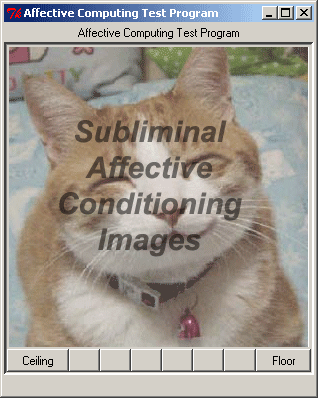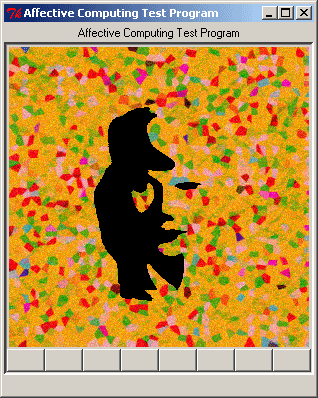|
Effects of Subliminal Conditioning
on Computer Program Users
by Hyemin Chung
Experiment Design
Basically, the experiment is done with programs which contain pre-study questionnaire, dummy tasks with subliminal affective conditionings, and post-study questionnaire.
The participants are divided into three groups.
The first group is a control group which uses a program with a blank image as a subliminal conditioning.
The second is a positively conditioned group which uses a program with a positive image as a subliminal conditioning.
The last one is a negatively conditioned group which uses a program with a negative image as a subliminal conditioning.
Basically, the experiment is done by running the program.
Participants do not know the purposes or the details of the experiment until they finish the experiment. They are just told that this experiment is about the relationship between psychology and user interfaces.
They are asked to run the program, to fully attend to it, not to stop, not to suspend, and not to re-run the program during the experiment.
If the volunteers have been exposed to the program or the experiment in any way, they are excluded from the experiment for the best results.
The program takes around 10 minutes.
Subliminal Affective Conditioning
Below are the subliminal affective conditioning images used in each program.
These images are selected based on the opinions of three people and IAPS data, and a little saturated to avoid being recognized by users.
In the program, there is no border around the images.

The Subliminal Conditioning Image
for the Control Group

The Subliminal Conditioning Image
for the Positive Group

The Subliminal Conditioning Image
for the Negative Group
Program
The program used in the experiment can be downloaded in HERE.
When the program starts, it randomly chooses the conditioning mode among the control group, the positive group, and the negative group. By the conditioning mode the program shows the subliminal image for 109 times during the experiment without users' recognition.
Image Hiding
Because of the slow speed of the LCD monitors, there remain afterimages on the monitors. Thus, if the program shows the subliminal images in normal ways, users can recognize something is flashing.
To avoid be recognized by the users, I put the subliminal images between the scene and scenes.
At first, the program shows a scene for a relatively long time, and then it shows the subliminal image for the shortest time possible (hopefully less than 1/30 seconds), and then it shows another scene.
Scene 1
|

|

|
Subliminal Affective Conditioning
for less than 1/30 seconds
|

|

|
Scene 2
for more than 2 seconds
|

|
Structures
1. Pre-experiment Questionnaire
The pre-study questionnaire is designed for two purposes.
1) To gather basic information about participants.
2) To minimize external effects such as weather, environment, or hunger by asking the questions about those information before the experiment.
2. Dummy Tasks
The dummy tasks is designed for two purposes.
1) To make participants spend around ten minutes with the program.
2) To expose participants to the subliminal conditioning images without their recognition.
3) To hide the purpose of the experiment.
There are three kinds of dummy tasks.
1) Picture Counting - questions like "how many pictures were there?"
2) Optical Illusions - questions like "what do you think the picture is about?"
3) Picture Scoring - quesions like "how do you like the picture?"
3. Post-experiment Questionnaire
The post-experiment questionnaire is designed to collect result data.
|
|